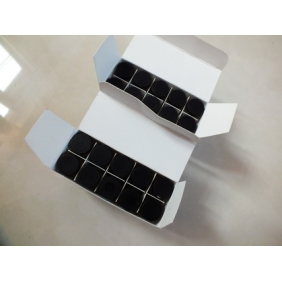

US DOMESTIC DELIVERY.
Country of origin: CHINA
�
Clinical pharmacology
A: Tissue Growth
1. Skeletal Growth: GH stimulates skeletal growth in children with growth failure due to a lack of adequate secretion of endogenous GH or secondary to chronic renal insufficiency and in patients with Turner's syndrome. 2. Cell Growth: Treatment with rhGH results in an increase in both the number and the size of skeletal muscle cells.
3. Organ Growth: GH influences the size of internal organs, including kidneys and increases red cell mass. Treatment of hypophysectomized or genetic dwarf rat with GH results in organ growth that is proportional to the overall body growth.
B: Protein Metabolism
Linear growth is promoted in part by GH stimulated protein synthesis. This is reflected by nitrogen retention as demonstrated by a decline in urinary nitrogen excretion and blood urea nitrogen during GH therapy. C: Carbohydrate Metabolism
Hypopituitary children sometimes experience fasting hypoglycemia that may be improved by treatment with rhGH. Large dose of rhGH may impair glucose tolerance.
D: Lipid Metabolism
In-growth-hormone-deficient patients administration of rhGH has resulted in lipid mobilization, reduction in body fat stores; and increased plasma fatty acids.
E: Mineral Metabolism
Retention of sodium, potassium and phosphorus is induced by administration of rhGH.
Absorption, distribution and excretion
Subcutaneous and intramuscular pharmacokinetic profiles of rhGH are similar, and usually the subcutaneous administration results in a higher serum GH level but produces the same IGF-I level, compared with intramuscular route. Peak plasma levels are reached in 3-5 hours following administration and the elimination half life is 2-3 hours. The elimination takes place in liver and kidneys, faster in adults than in children, less GH is detected in urine after metabolism. Serum GH is not influenced by the time selected for injection in a day and endogenous peak GH level is reached usually following the slow-wave sleeping phase, so the administration at night before sleep is recommended.
Indications
Conventional indications:
1. Long-term treatment of children who have a growth failure due to a lack of endogenous growth hormone secretion.
2. Treatment of children who have growth failure associated with chronic renal insufficiency up to the time of renal transplant.
3. Patients suffered from Turner�s syndrome.
Unconventional indications:
Supplement in aging, and in management of cachexia secondary to some chronic diseases; also in restoration of positive nitrogen balance due to burn or surgery, etc.
Contraindications
1. Should not be used in subjects with closed epiphysis.
2. Should not be used in patients with active neoplasia.
3. Should not be used in pregnant women and nursing mothers.
Precautions
Prior to the administration, a competent medical expert is needed for intensive guidance.
1. For diabetic patients, the dose of antihyperglycemic may be adjusted regularly.
2. Patients with growth hormone deficiency secondary to an intracranial neoplasm or lesion should be examined frequently for progression or recurrence of the underlying disease.
3. Concomitant glucocorticoid therapy may inhibit the growth hormone promoting effects; Patients with coexisting ACTH deficiency should have their glucocorticoed replacement dose carefully adjusted to avoid an inhibitory effect on growth treatment.
4. Hypothyroidism may develop during administration of rhGH, patients should have periodic thyroid function tests and treated with thyroid hormone when indicated.
Dosage and Administration
The dosage should be individualized.
Generally recommended dosage for long-term treatment of children who have growth failure due to hGH deficiency.
For subcutaneous injection:
0.1-0.2 IU/kg body weight, 6-7 times a week, or 2-3 IU/m2 body surface area 3 times a week.
For intramuscular injection:
0.2-0.24 IU/kg body weight, 3 times a week, or 4-6 IU/ m2 body surface area 3 times a week.
For other application, please consult your medical experts.
Dissolution procedure
1. Use a syringe and needle for injection. Before injection, the rubber closures should be wiped with an antiseptic solution to prevent contamination after repeated needle insertions. Push the needle through the rubber closures on the top of the vial with diluent, draw up the diluent. 2. Pull out the needle, Take the vial with dry powder push the needle through the rubber closure and inject the diluent into the vial aiming the stream of liquid against the glass wall.
3. Dissolve the dry powder completely by gently turning the vial upside and down several times. Do not shake the vial vigorously.
Adverse reactions and Storage
Adverse reactions
Injected site discomfort and mild transient peripheral edema have been reported at early stage following administration, but occurrence rates are decreases as the administration continues.
Storage
The dry powder is stable until the date of expiry indicated on the label, provided it is kept in a cool place (2-8 o C). The dissolution of the dry powder, the solution is stable for 24 hours if kept at 2-8 o C. Avoid freezing, avoid direct sunlight.
By selecting any product for purchase, you are legally confirming that you are at least 21 years old or older of a legal age within your state/area/country to possess, use or buy anabolic steroids (performance enhancing drugs). By accepting these conditions you are indicating that you are of legal age to order steroids online from our store. You must determine your right to purchase, own, or use specific anabolic steroids offered by truelab.is in your jurisdiction. As local laws are constantly changing, it's your responsibility to determine if a steroid compound is prohibited before purchasing online from our anabolic store.
